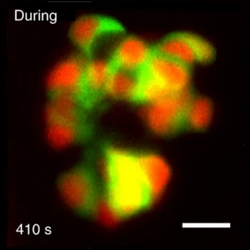Leader β-cells coordinate Ca2+ dynamics across pancreatic islets in vivo
Pancreatic β-cells form highly connected networks within isolated islets. Whether this behaviour pertains to the situation in vivo, after innervation and during continuous perfusion with blood, is unclear. In the present study, we used the recombinant Ca2+ sensor GCaMP6 to assess glucose-regulated connectivity in living zebrafish Danio rerio, and in murine or human islets transplanted into the anterior eye chamber. In each setting, Ca2+ waves emanated from temporally defined leader β-cells, and three-dimensional connectivity across the islet increased with glucose stimulation. Photoablation of zebrafish leader cells disrupted pan-islet signalling, identifying these as likely pacemakers. Correspondingly, in engrafted mouse islets, connectivity was sustained during prolonged glucose exposure, and super-connected ‘hub’ cells were identified. Granger causality analysis revealed a controlling role for temporally defined leaders, and transcriptomic analyses revealed a discrete hub cell fingerprint. We thus define a population of regulatory β-cells within coordinated islet networks in vivo. This population may drive Ca2+ dynamics and pulsatile insulin secretion.
Back to list
